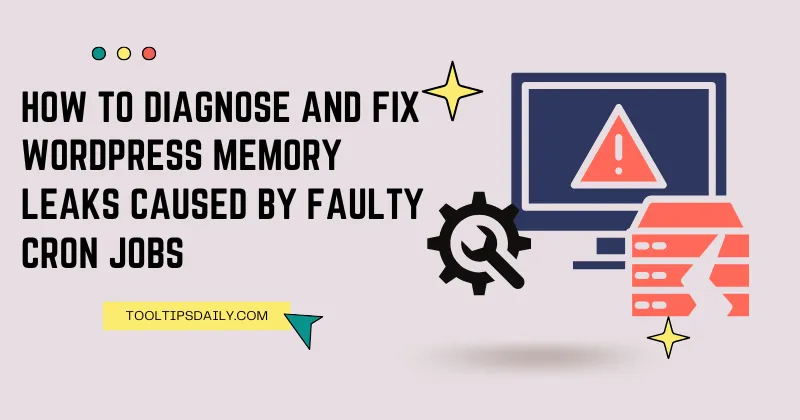WordPress is a powerful platform, but it’s not immune to performance issues like WordPress memory leaks, especially when faulty cron jobs are involved. A memory leak occurs when a process consumes more memory than necessary and fails to release it, slowing down your site or causing crashes. Faulty cron jobs—scheduled tasks that run in the background—can exacerbate this issue by executing inefficient code repeatedly. As a WordPress developer with years of experience troubleshooting performance bottlenecks, I’ve seen how unchecked cron jobs can cripple even well-optimized sites. In this article, I’ll walk you through how to diagnose and fix WordPress memory leaks caused by faulty cron jobs, using practical steps and real-world insights.
Understanding WordPress Memory Leaks and Cron Jobs
A memory leak in WordPress often stems from poorly coded plugins, themes, or custom scripts that fail to manage resources efficiently. Cron jobs, which handle tasks like publishing scheduled posts, sending emails, or updating plugins, can become problematic when they run excessively, get stuck in loops, or execute memory-intensive operations. These faulty cron jobs can overwhelm your server’s memory, leading to errors like “PHP Fatal Error: Allowed Memory Size Exhausted.”
WordPress uses a pseudo-cron system called WP-Cron, which triggers tasks when a visitor loads a page. If your site has high traffic or misconfigured cron jobs, WP-Cron can fire too frequently, amplifying memory leaks. Let’s explore how to identify and resolve these issues.
Step 1: Diagnosing Memory Leaks Caused by Faulty Cron Jobs
Before fixing a memory leak, you need to confirm that faulty cron jobs are the culprit. Here’s how to diagnose the issue systematically.
Check Server Logs for Memory Errors
Start by reviewing your server’s error logs. Look for messages indicating memory exhaustion, such as:
PHP Fatal error: Allowed memory size of 268435456 bytes exhaustedThese logs often point to the script or plugin responsible. Access logs via your hosting control panel or SSH (e.g., /var/log/php_errors.log).
Monitor WP-Cron Activity
To see what cron jobs are running, install a plugin like WP Crontrol. This tool lists all scheduled tasks, their frequency, and associated hooks. Look for cron jobs that run too often (e.g., every minute) or have unfamiliar hooks, which could indicate a faulty plugin.
Use Debugging Tools
Enable WordPress debugging to capture detailed error messages. Add the following lines to your wp-config.php file:
define('WP_DEBUG', true);
define('WP_DEBUG_LOG', true);
define('WP_DEBUG_DISPLAY', false);Check the debug log (wp-content/debug.log) for errors related to cron jobs or memory usage. For deeper insights, use a tool like Query Monitor to track resource-intensive processes.
Assess Memory Usage
Install a server monitoring tool like New Relic or use your hosting provider’s resource usage dashboard. These tools show memory consumption spikes, which often correlate with cron job execution times.
| Tool | Purpose | External Link |
|---|---|---|
| WP Crontrol | View and manage cron jobs | WP Crontrol Plugin |
| Query Monitor | Monitor database queries and performance | Query Monitor Plugin |
| New Relic | Track server resource usage | New Relic |
Step 2: Identifying Faulty Cron Jobs
Once you’ve confirmed a memory leak tied to cron jobs, pinpoint the problematic tasks. Common culprits include:
- Plugin-related cron jobs: Plugins like e-commerce or SEO tools often schedule frequent tasks that consume excessive memory.
- Custom code: Developer-added cron jobs in functions.php or custom plugins may lack proper optimization.
- Stuck cron jobs: Tasks that fail to complete can queue up, overloading the server.
Audit Cron Schedules
Using WP Crontrol, review the cron schedules. Pay attention to:
- Frequency: Tasks running every few seconds or minutes are red flags.
- Hook names: Unfamiliar hooks may belong to outdated or poorly coded plugins.
- Arguments: Some cron jobs pass large datasets, increasing memory usage.
Test by Disabling WP-Cron
Temporarily disable WP-Cron to see if memory issues persist. Add this line to wp-config.php:
define('DISABLE_WP_CRON', true);If memory usage stabilizes, a cron job is likely the issue. Re-enable WP-Cron after testing to avoid disrupting scheduled tasks.
Step 3: Fixing Faulty Cron Jobs to Stop Memory Leaks
With the problematic cron jobs identified, take these steps to resolve the memory leaks.
Optimize or Remove Problematic Plugins
Deactivate plugins one by one, monitoring memory usage after each deactivation. If a plugin’s cron job is the culprit, check for updates or contact the developer for a fix. Alternatively, replace it with a lighter plugin. For example, swap heavy SEO plugins for streamlined alternatives like Rank Math.
Adjust Cron Schedules
If a cron job is essential but runs too frequently, adjust its schedule. Use WP Crontrol to modify the recurrence (e.g., from every minute to once daily). For advanced users, edit the cron schedule in code:
add_filter('cron_schedules', function($schedules) {
$schedules['daily'] = array(
'interval' => 86400, // 24 hours in seconds
'display' => __('Once Daily')
);
return $schedules;
});Offload WP-Cron to Server Cron
WP-Cron’s reliance on page loads can cause inconsistent execution and memory spikes. Offload it to a server-level cron job for better control. Follow these steps:
- Disable WP-Cron in wp-config.php:
define('DISABLE_WP_CRON', true);- Set up a server cron job via your hosting panel or SSH. For example, run this command every 15 minutes:
*/15 * * * * wget -q -O - https://yourdomain.com/wp-cron.php?doing_wp_cron >/dev/null 2>&1This ensures cron jobs run on a fixed schedule, reducing memory strain.
Optimize Custom Code
If custom cron jobs are causing leaks, review the code for inefficiencies. Common issues include:
- Unclosed database connections: Ensure queries use wpdb properly and release resources.
- Large data processing: Break tasks into smaller batches to reduce memory usage.
- Infinite loops: Add exit conditions to prevent runaway processes.
Here’s an example of an optimized cron job that processes data in batches:
add_action('my_custom_cron', 'process_large_dataset');
function process_large_dataset() {
global $wpdb;
$batch_size = 100;
$offset = get_option('my_cron_offset', 0);
$results = $wpdb->get_results("SELECT * FROM {$wpdb->prefix}my_table LIMIT $offset, $batch_size");
if (empty($results)) {
update_option('my_cron_offset', 0); // Reset offset
return;
}
foreach ($results as $row) {
// Process each row
}
update_option('my_cron_offset', $offset + $batch_size);
}How to Add Custom REST API Endpoints to Your WordPress Site
Increase PHP Memory Limit (Temporary Fix)
If immediate fixes aren’t possible, increase the PHP memory limit as a stopgap. Edit wp-config.php:
define('WP_MEMORY_LIMIT', '256M');Or update your php.ini file:
memory_limit = 256MThis is not a long-term solution, as it doesn’t address the root cause of the memory leak.
Step 4: Preventing Future Memory Leaks
To avoid recurring issues with faulty cron jobs, adopt these best practices:
- Regularly audit plugins: Deactivate unused plugins and update active ones.
- Monitor cron performance: Use WP Crontrol to check schedules monthly.
- Use lightweight code: Optimize custom scripts and avoid memory-intensive operations.
- Leverage caching: Implement object caching (e.g., Redis or Memcached) to reduce database queries triggered by cron jobs.
Conclusion
Fixing WordPress memory leaks caused by faulty cron jobs requires a methodical approach: diagnose the issue, identify problematic tasks, apply targeted fixes, and adopt preventive measures. By using tools like WP Crontrol, Query Monitor, and server logs, you can pinpoint and resolve memory-intensive cron jobs. Offloading WP-Cron to a server cron job and optimizing code further ensures your site runs smoothly. With these steps, you’ll not only fix current memory leaks but also build a more resilient WordPress site.
7 Advanced .htaccess Tips to Secure Your WordPress Blog from Spam and Security Threats

